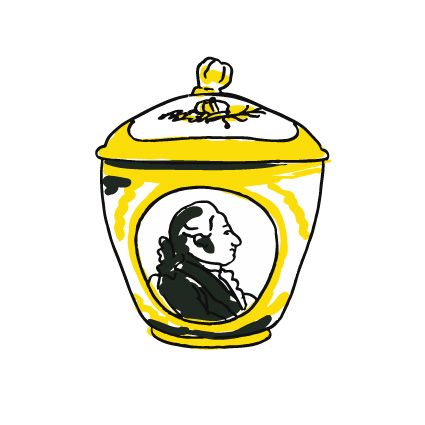
Ezzel a 18. század végén gyártott meisseni porcelán kávéscsészével, akkor találkoztam először, amikor évekkel ezelőtt tárgyakat válogattam egy műtárgyfotózáshoz. A 18–19. századi főúri reprezentáció mindig is érdekelt, melynek kiváló kifejező elemeinek tartom az egyes nemesi családok egykoron használatban lévő tárgyait.
A műtárgy Vajkai Aurél néprajzkutató igazgatóságának időszakában (1949–1955) került be múzeumunk Iparművészeti gyűjteményébe. A Magyar Népköztársaság Elnöki tanácsa 1952. február 17-én hirdette ki azon törvénycikkét (4. tc.), amely bizonyos házingatlanok állami tulajdonba vételét írta elő. A törvény végrehajtását követően a múzeum gyűjteményeibe közel 2000 olyan műtárgy került, amelyek arisztokrata, illetve polgári családok egykori ingóságai voltak. Többek között ez a kávéscsésze is ezen állami rendelkezés következményeként lett része a gyűjteménynek. A csésze sötétkék alapszínű, oldalán XVI. Lajos francia uralkodó (1774–1792) portréja látható. Az aljon Mária Terézia királynő legkisebb leánya, a francia uralkodó felesége, Marie Antoinette (1755–1792) portréja vehető szemügyre.
A 18. század folyamán az asztali készletben helye volt a kávéscsészének. A kávéfogyasztás hagyománya a 18. században nyugat-európai új szokásként kezdett elterjedni bécsi közvetítéssel, és nem török hatásra. Ennek ellentmond, hogy egyes családoknál már korábban is találhatunk kávéfogyasztásra utaló eszközöket. Azonban tény, hogy Magyarországon már a török hódoltság időszakában is ismerték a kávét. A 17–18. század fordulóján a kávéfogyasztás elterjedt Magyarországon, amely elérte a kollégiumi diákoktól kezdve a pesti és a vidéki kispolgár asszonyt egyaránt. A parasztok szemében a kávéfogyasztás nemesi szokásnak számított, ugyanakkor 1770 után olcsó cikória pótkávé is forgalomba került, így az alacsonyabb társadalmi rétegű személyek számára is elérhetővé vált. Első kísérletek a kávéfőzésre a paraszti háztartásokban az 1850-es évekből ismeretesek. Ünnepi alkalmakkor készítettek a főétkezések végén városi vendégeik számára kávét.
A bemutatott műtárgyat a 18. század végén alkották Meissenben. A gróf Pejachevich család tulajdonában volt, a porva-szépalmapusztai birtokukon használták ezt a kávéscsészét. A díszes, finom kidolgozású porcelántárgyaknak nem csak az étkezésben jutott szerepük, hanem a főúri reprezentációban is. Az európai királyi udvarokban, valamint az arisztokrácia körében a 18–19. században a porcelán státuszszimbólumnak számított.
Fogl Krisztián
történész
Erre haladjon tovább:
A hármas számú vitrin bal belső lábán lévő QR-kód avar titkokat rejt!
The first time I came across this 18th century porcelain coffee cup from Meissen, was when I was sorting items for an artifact photoshoot. The aristocratic representation of the 18th and 19th centuries was always an interest of mine, of which I consider the everyday items coming from noble families an exceptionally expressive element.
This item became part of the museum’s applied arts collection under the management of ethnographer Aurél Vajkai (1949-1955). In february 17, 1952, the Presidential Council of the Hungarian People’s Republic announced their law article (article 4) in which they announced the nationalisation of certain residential properties. After the implementation of this law, close to 2000 artifacts ended up in the collections of the museum, which was the personal property of various aristocratic or civic families. The aforementioned coffee cup became part of our collections due to this government regulation. The cup's primary color is dark blue, on its side the portrait of French ruler Louis XVI can be seen. On the base, the youngest daughter of Maria Theresa, Marie Antoinette (1755-1792) is seen in another portrait depiction.
During the 18th century the coffee cup had a place in tableware sets. The tradition of coffee drinking began to spread in the 18th century. As a new Western-European custom, it spread through Viennese mediation, not because of Turkish influence. On the contrary, items indicating coffee consumption can be found among certain families, prior to the widespread custom. However it is a known fact that coffee was already known in Hungary during the period of Turkish occupation. At the turn of the 17th and 18th centuries, the custom of coffee drinking spread throughout Hungary as well, as it reached both the college students and the middle-class women of Budapest and the countryside alike. In the eyes of peasantry, coffee was seen as a luxurious, aristocratic habit. However, after 1770, a cheap chicory coffee substitute began circulating the market, which made this tradition more accessible to the people of the lower social classes. The first attempts of coffee brewing in peasant households are known from the 1850s. The coffee was made on special holiday occasions and it was served at the end of the main meals, to the family’s guests who came from the city.
The presented artifact was made in Meissen, at the end of the 18th century. The cup was the property of the count Pajachevich family, it was used in their property on Porva-Szépalmapuszta. The decorated, finely crafted porcelains did not only play a role in dining, but also served as a symbol of aristocratic representation. During the 18th and 19th centuries, such items were considered a status symbol in the European king’s courts and aristocratic circles.
Krisztián Fogl
historian
Proceed to this:
The QR code on the left inner leg of display case three holds Avar secrets!